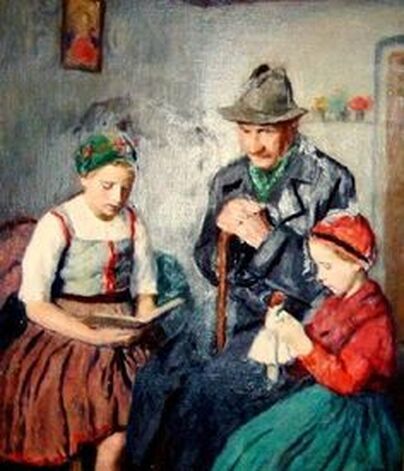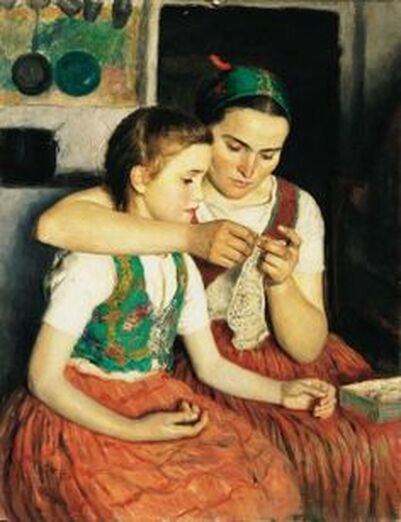The Curious Case of Oszkár Glatz
 Oszkár Glatz (1872 - 1958) was a Hungarian painter whose life spanned one of the most tumultuous and unstable periods in Hungarian history. Born five years after the Austro-Hungarian Compromise of 1867, Glatz began life as citizen of an unsteady dual monarchy the Habsburgs hammered out after they quelled the unsuccessful Hungarian Revolution of 1848 that sought Magyar independence from Austria, only to see this political union evaporate immediately after the First World War. Austria-Hungary became the Hungarian People's Republic before Béla Kuhn successfully inspired a communist revolution that quickly ushered in the Hungarian Soviet Republic. In 1920, Kuhn's communist state crumbled under the backlash of a counterrevolution that saw the communists driven from power and the establishment of the Regency years under the leadership of Miklós Horthy. Hungary allied with Germany in the Second World War, but was occupied by Nazi forces who established a fascist government under the flag of the Arrow Cross Party after Hitler lost faith in Horthy in 1944. When the war ended, Hungary was under Soviet occupation and over the course of the next three years became a satellite state of the Soviet Union. Glatz's final years as an old man coincided with the so-called Stalinist years of 1949-1956, which were the most oppressive years Hungary experienced under communism. The communists succeeded in making life so unbearable that it inspired Hungarians to rise up against them in 1956. The uprising ultimately failed, but it opened the door to reforms and ushered in a more lenient form of communism in Hungary that eventually evolved into what became known as "goulash communism."
Oszkár Glatz (1872 - 1958) was a Hungarian painter whose life spanned one of the most tumultuous and unstable periods in Hungarian history. Born five years after the Austro-Hungarian Compromise of 1867, Glatz began life as citizen of an unsteady dual monarchy the Habsburgs hammered out after they quelled the unsuccessful Hungarian Revolution of 1848 that sought Magyar independence from Austria, only to see this political union evaporate immediately after the First World War. Austria-Hungary became the Hungarian People's Republic before Béla Kuhn successfully inspired a communist revolution that quickly ushered in the Hungarian Soviet Republic. In 1920, Kuhn's communist state crumbled under the backlash of a counterrevolution that saw the communists driven from power and the establishment of the Regency years under the leadership of Miklós Horthy. Hungary allied with Germany in the Second World War, but was occupied by Nazi forces who established a fascist government under the flag of the Arrow Cross Party after Hitler lost faith in Horthy in 1944. When the war ended, Hungary was under Soviet occupation and over the course of the next three years became a satellite state of the Soviet Union. Glatz's final years as an old man coincided with the so-called Stalinist years of 1949-1956, which were the most oppressive years Hungary experienced under communism. The communists succeeded in making life so unbearable that it inspired Hungarians to rise up against them in 1956. The uprising ultimately failed, but it opened the door to reforms and ushered in a more lenient form of communism in Hungary that eventually evolved into what became known as "goulash communism."Though Oszkár Glatz lived through a great deal of political instability, his art remained remarkably apolitical throughout the bulk of his life. Instead of becoming bogged down in politics, Glatz dedicated his creativity to depicting traditional Hungarian family and community scenes. Many modern people would consider his painting to be over-idealized, perhaps even kitschy, but in my mind Glatz's paintings, despite their obvious idealism, are respectable and charming representations of Beauty, Truth, and Goodness. What I admire most about his art is his ability to capture scenes from Hungarian rural life, scenes portraying the positive essence of relationships within families and communities. Looking at his paintings motivates one to think "now this is what family and friendships are all about." In a way, he is could be considered a Magyar Norman Rockwell.





 Oszkár Glatz was 74 years old when the transition to communism began in Hungary. He already had a long and relatively successful career behind him, a career in which he had avoided depicting the explicitly political in his painting. Of course, many would argue Glatz's idealized paintings of rural people and scenes contain an implicit political message, but for the sake of this post let us just assume he was aiming at representing nothing more than scenes from family life - that his intention was to represent loving relationships between family members. Had Glatz left his painting there, he would have remained an uncontroversial artist in Hungarian art history.
Oszkár Glatz was 74 years old when the transition to communism began in Hungary. He already had a long and relatively successful career behind him, a career in which he had avoided depicting the explicitly political in his painting. Of course, many would argue Glatz's idealized paintings of rural people and scenes contain an implicit political message, but for the sake of this post let us just assume he was aiming at representing nothing more than scenes from family life - that his intention was to represent loving relationships between family members. Had Glatz left his painting there, he would have remained an uncontroversial artist in Hungarian art history.But Glatz continued to paint during the transition to communism, and his painting from the 1950s reveal some perplexing choices. The painting below is called "Young Pioneer Visits Her Village Friends." (Young pioneers were essentially communist boy scouts and girl scouts although in terms of being ideologically driven, they were more along the lines of Germany's Hitlerjugend. For example, the communists routinely indoctrinated young pioneers to spy and inform on their families and neighbors). The painting below follows the same "formula" Glatz employs in so many of his other works, but his inclusion of the young pioneer girl disturbs the aura of Beauty, Truth, and Goodness Glatz had maintained throughout his earlier representations of simple rural life.
 Another painting, one depicting Hungarian young pioneers enthusiastically examining a globe with their North Korean communist peers, is pure Socialist Realism.
Another painting, one depicting Hungarian young pioneers enthusiastically examining a globe with their North Korean communist peers, is pure Socialist Realism.  Attempting to understand how an artist like Glatz became so enamoured with communism so late in life is difficult and perplexing. I have read that he became disillusioned with the traditional scenes he painted. I read elsewhere that he merely developed his family themes to the communist level of the universal proletariat family. Some sources claim he became a true believer. Others argue his communist paintings had more to do with expediency than ideology.
Attempting to understand how an artist like Glatz became so enamoured with communism so late in life is difficult and perplexing. I have read that he became disillusioned with the traditional scenes he painted. I read elsewhere that he merely developed his family themes to the communist level of the universal proletariat family. Some sources claim he became a true believer. Others argue his communist paintings had more to do with expediency than ideology.Whatever the case, somewhere in the late 1940s, when Glatz was already well into his seventies, he made a conscious decision to move away from the subject matter he had painted his entire life and begin painting idealized scenes of communist life. He was an octogenarian when he painted the scene with the young pioneer visiting her friends. Though some maintain Glatz had been more or less forced into shifting into communist themes, my intuition tells me his choice had been voluntary - that he honestly believed in the paradise communism professed to offer. If he hadn't, he would not have bothered to make the transition. After all, the communists permitted retirement, especially to people in their seventies and eighties - but Glatz chose to remain active. He could have put away his brush and hung up his apron and simply say he was too old and tired to paint anymore, but he didn't - and that, in my opinion, pretty much says it all.
Published on September 07, 2019 05:06
No comments have been added yet.



